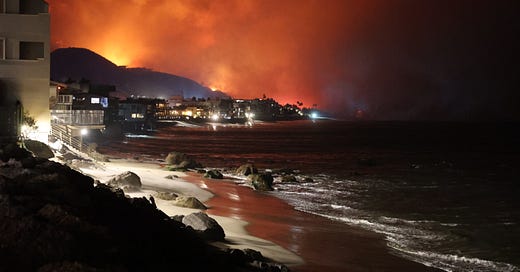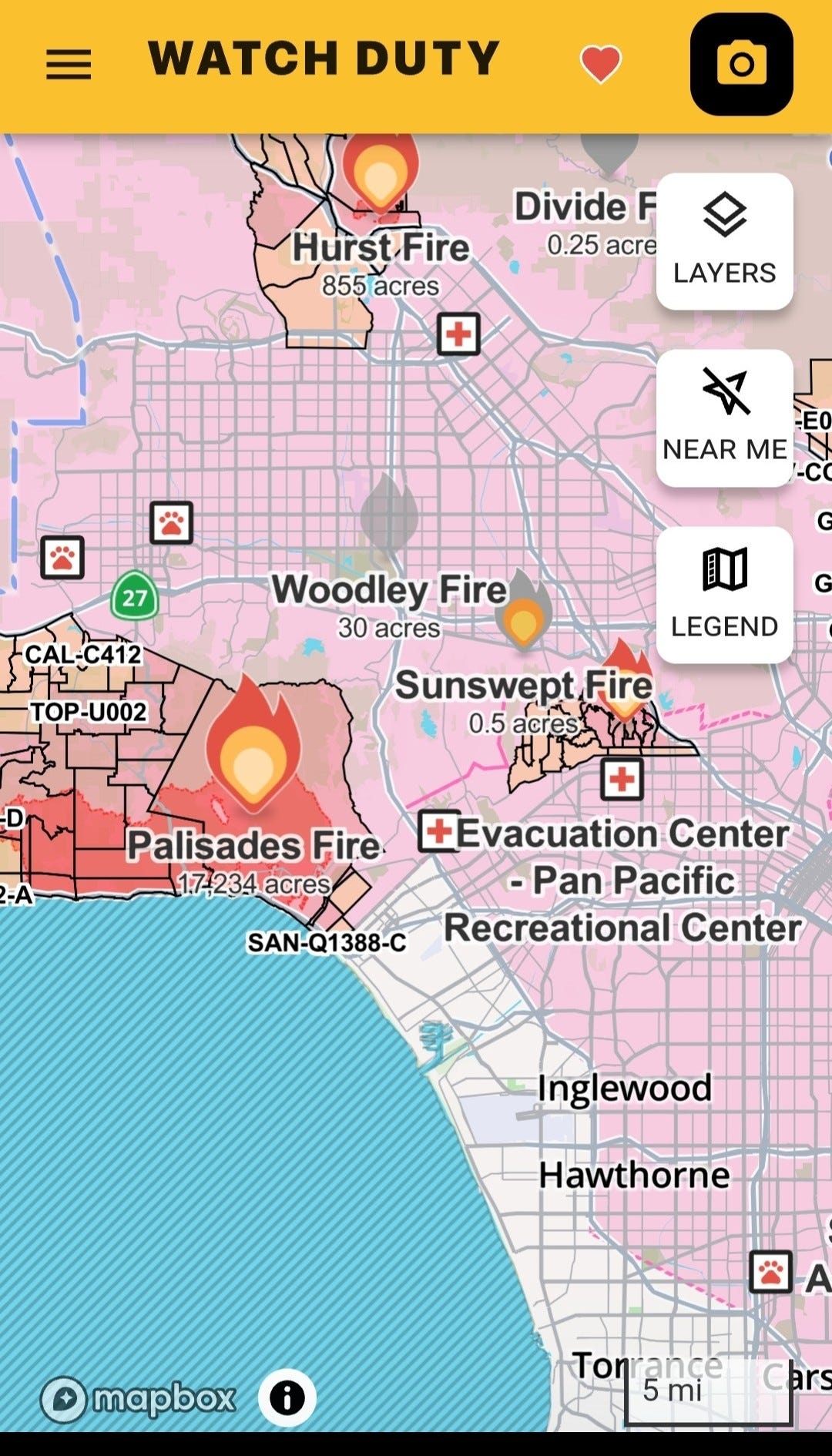Mind and Iron: What the L.A. Wildfires Tell Us About How We'll Soon Live
Through the haze, a different vision of the future
Hi and welcome back to another juicy episode of Mind and Iron. I'm Steven Zeitchik, veteran of The Washington Post and Los Angeles Times and your chief curator of this newsy Dada installation.
Every Thursday we bring you the best of where we're going — what our future holds and how we can best be on track for a humanist one. Please consider supporting us.
I had planned a whole issue this week about CES and the various developments there, especially robots, which had a moment this year and hinted at both some pretty rich and pretty ridiculous possibilities. But with the wildfires in Los Angeles — the city I currently inhabit — I decided to defer that to next week and do a quicker but more timely post on what's happening here.
More specifically, what some of the response to what's happening here foretells about our future. Because from political weaponization to climate migration, we're seeing our decade ahead unfold through the haze of this awful tragedy.
Also, for an understanding of where our local-news zeitgeist is going (and how it's already in a bad place) via the muddy lens of wildfire coverage, check out the Substack of M&I pal Matt Pearce, who had an excellent post Wednesday on the subject.
First, the future-world quote of the week.
"California's been good to me. Hope it don't fall into the sea."
— Tom Petty, c. 1994., in a lyric that suddenly seems a lot less hyperbolic
Let's get to the messy business of building trying to reach the future.
**
MOVING. A mushroom cloud, both literal and figurative, has been hovering over my neighborhood in Los Angeles this week. I've not been forced to evacuate — yet — but there's nothing that gets one mind racing about how to build a brighter future than living in an apocalyptic present. The first subject that comes to mind is…moving.
I was talking to a source as the craziness began and they said they thought this would be a turning point for Los Angeles as a dwelling spot for many of its entertainment-biz workers. That, thanks to technology, executives increasingly don't have to live here, and producers and actors and crew increasingly have to live somewhere else, given how much production has leaked out of Los Angeles lately.
High prices and taxes, traffic, struggling school districts, sprawl — all of this has already made Los Angeles a difficult place to live regardless of what job you're in. Tack on this environmental kicker — the real possibility of getting wildfired out of your home, never mind the anxiety of same — and it's going to drive all kinds of people from the city (and many places with extreme-weather risk).
Several slick interactive maps reveal the various levels of risk from flooding, fires and other climate-related doom. The best of them is the Climate Vulnerability Index, from the Environmental Defense Fund and Texas A&M. It shows by census tract exactly what percentile each area ranks in the U.S. in terms of these risks. Perhaps not so helpful if you're trying to determine the raw odds of something happening in your area. But if you’re thinking about moving and want to know if where you're going is better than where you've been, it's invaluable.
We'd also previously told you about the RiskFactor tool that assesses your probability of different kinds of climate disaster based on your address; that's pretty good too.
All these tools will get more common, and more accurate. The question after this week is: will they shape decision-making in a meaningful way? Will they make people look at a Los Angeles or other high-risk city they're living in and say ‘time to move?’
The places in America people are most likely to move to, according to the British science journalist Gaia Vince, who has studied this extensively (she is the author of "Nomad Century," about this topic) are Great Lakes spots in Minnesota and Wisconsin and Michigan and their ilk. Such places not prone to extreme dryness, they don't generally face risks of hurricanes, and the lakes tend to keep them temperate.
Migration theories tend to engender skepticism, because migration, like life for Kierkegaard, can only be understood backward; try to predict where people will go and you look silly. Still, Vince makes a compelling case that a series of disastrous events in the coming decades will prompt just these shifts. How did we get from Malibu to Duluth? Gradually at first, then all at once.
In the case of California, that exodus has of course already been happening. The state has been seeing a steady population drop over the last 15 years, an incredible stat given how long the boom period had gone on for. Some 8.5 million people have left California for other states since 2010 while only 6.3 million moved here. Obviously this is due to a complex set of factors. But when weeks like this happen, you can better understand the trend — and also imagine it accelerating.
What's funky is the role technology plays in all of this. On one hand it can limit climate disasters. A firefighting conference just announced a summit on cutting-edge technology, and a slew of drones and satellites have been used to map the fires this week. There is an irony here: Technology is a tool to contain the fires that technology, with all its fossil fuels and data-center heat, also helped start.
What's maybe most notable about tech here, though, is the way it allows for virtual work — Zoom and soon enough VR. This is an environmental lifesaver. Metaverse-based remote work may be the biggest enabler of migrations away from weather hot-spots by simply removing the main reason they had for staying in them. (Employers insisting on full-on office appearances are missing the boat by forcing employees into overpopulated places and then jamming too many of them into polluting cars once there).
Each time something awful like the wildfires happen, more and more people will find ways to keep their jobs and live elsewhere, or get a job that doesn't care where they live. If we seem unable to do much to reduce climate havoc, at least we can try to get out of its way.
MENDACITY: Anyone who has spent any amount of time checking on Southern California weather conditions on social media this week, and by checking on Southern California weather conditions I mean abject doomscrolling, has noticed something that’s damn near impossible to miss: there sure are a lot of conspiracy theories out there. Eco-terrorists are setting the fires to raise awareness for climate change, or Luigi Mangione types are lighting fires to take down celebrities, or Gavin Newsom indirectly created the fires because he was trying to save a fish (literally, this is the theory espoused by our incoming president) or any of an untold number of outlandish and deeply false scenarios.
I was in the middle of reading an infamous conspiracy theorist pronouncing how the sending of supplies to Ukraine was forcing the LAFD to use women’s handbags (wrong and offensive on about four levels) when I had to stop. Such was the absurdity assaulting us this week.
We can laugh about such trollishness, but they’re quite serious: all of these so-called explanations create a bogeyman that isn’t there, while shifting attention away from the real villain: reckless development and corporate behavior (and really loose regulations to stop them). The exceedingly drought-like conditions aren’t just happenstance or a random act of divine punishment; they’re verified by every scientist in Christendom as the end-point of all the ways we’ve polluted the environment. Of course if you focus on all the above nonsense you can ignore that and conveniently keep polluting and developing.
I wrote a Hollywood Reporter piece about this, so I’ll toss you over there to read the whole thing. Suffice to say that the issue is going to get bigger and bigger as more and more extreme-weather events happen. Climate disasters (unlike man-made dangers such as terrorist attacks) suck up conspiracy theories like a Roomba because there’s no immediately obvious villain. They have also have a lot of motivated players intent on distracting us from the underpinnings.
It would seem there’s no way to curb this issue— the more wildfires, the more smoke thrown up to prevent us to see what’s causing them.
Theoretical hope lies only with the platforms. Social media could be a bulwark if the algorithms weren’t programmed to “engage us” (i.e. get us mad) and if the people running them cracked down on paid trolls there to manufacture “sentiment” and if the people running them were also willing to throw in a professional fact-check now and again — i.e., the job that’s literally protected the free press for an eternity. All of this is possible. All of this would obviously help. And all of this is, of course, being shirked.
And once again, this week brings a warning sign: if we seem unable to do much to reduce climate havoc, perhaps it’s because we’ve turned our communications channels over to those who don’t mind wreaking it. Time to start taking them back.
MONITORING: Finally, the Watch Duty app. I hadn’t heard of it before this week. Chances are if you’re not in California you still haven’t heard of it. But the app, which gives you real-time granular info on various fires, has been a lifesaver in so many ways.
In an environment where there’s simply no way to know with accuracy where the climate danger is spreading — news media is too general, social media is too unreliable, and do you really want to turn over life-and-death decisions to unpredictable government cell-phone alerts — Watch Duty comes in to save the day. It gives you so much information you feel like the meteorologist is sitting in your living room telling you it’s all going to be OK (or not). But also it gives you that information with a seductive simplicity — the location of the fire, its severity and its direction with a very easily navigable interface.
The app has a cool history, started and staffed by volunteers back during the 2021 fire season and run as a nonprofit. Mainly it relies on scannerheads and everyday people in hard-to-reach spots for its reporting. And it often gets out its information faster than government authorities. As this Wired profile from a few years ago tells it, Watch Duty “shoots straight for its core goal: telling people where a fire is right now, and where it is headed.” No two ways about it, Watch Duty is a wonderful invention, a Wikipedia of the apocalypse. And while it’s incredibly sad we need it, we should feel deeply fortunate to have it. I suspect this model will soon be replicated for other forms of climate disasters, for the simple evolutionary reason that if it isn’t, we won’t survive.
I’ll admit Watch Duty is addictive in a wonky way. Launch it and you’ll soon find yourself checking the wind direction in the foothills while wondering if the prescribed burn will be enough to achieve containment by sunrise; you’ll be ready for your consultant role on the “Backdraft” reboot, or just for the loony bin.
But it’s also crucial, able to literally tell you the level of danger and thus your ideal level of preparedness. If we seem unable to do much to reduce climate havoc, thank heavens we have a system that could alert us to it.
The Mind and Iron Totally Scientific Apocalypse Score
Every week we bring you the TSAS — the TOTALLY SCIENTIFIC APOCALYPSE SCORE (tm). It’s a barometer of the biggest future-world news of the week, from a sink-to-our-doom -5 or -6 to a life-is-great +5 or +6 the other way. This started on a positive note. This week? Not so much.
CLIMATE DISASTER IS PULLING UP A U-HAUL: -3.0
CLIMATE-DISASTER LIARS HAVE A LOT OF FRIENDS AND A LOT OF TOOLS: -3.5
A CLIMATE-DISASTER NONPROFIT APP SHOWS HOPE IS POSSIBLE: +2.0







